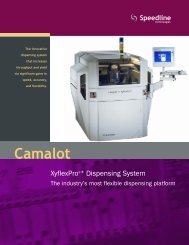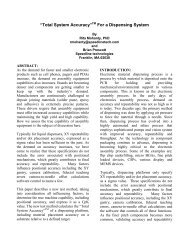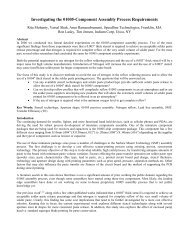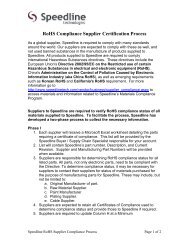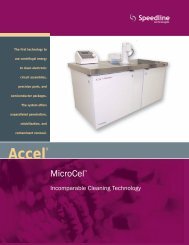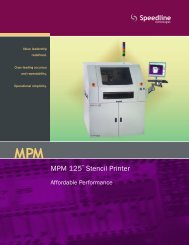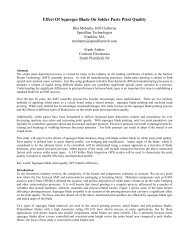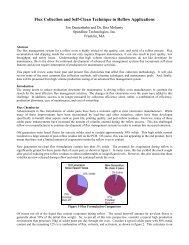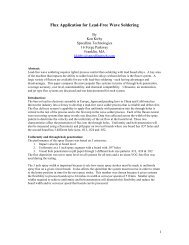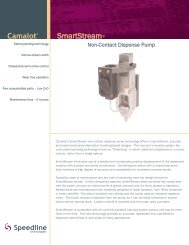Substrate Bumping for Micro BGA - Speedline Technologies
Substrate Bumping for Micro BGA - Speedline Technologies
Substrate Bumping for Micro BGA - Speedline Technologies
You also want an ePaper? Increase the reach of your titles
YUMPU automatically turns print PDFs into web optimized ePapers that Google loves.
Based on the DOE analysis, an optimum factor<br />
combination was determined <strong>for</strong> each type of paste<br />
and the result is presented below.<br />
Optical micrographs <strong>for</strong> both types of pastes are<br />
shown in figures 9 and 10. Pad sizes smaller than 100<br />
microns (4mil) showed acceptable paste transfer<br />
(qualitatively) but the registration was very poor<br />
(paste was printed of the pads) due to board stretch.<br />
In addition, the SPI machine used in this study was<br />
not able to inspect deposit below 100 microns size.<br />
Hence the result and discussion is restricted to pad<br />
size above 100 microns.<br />
As it can be seen from the above figures, the<br />
deposits were well <strong>for</strong>med without any bridging or<br />
insufficient <strong>for</strong> 200µ pad size. As the pad size<br />
decreased, even with higher area ratio, the paste<br />
transfer deteriorated due to extremely small aperture<br />
opening.<br />
Figures 11 shows the effect of pad size and<br />
web on the overall transfer efficiency <strong>for</strong> both noclean<br />
and water base paste.<br />
Figure 11. Effect of pad and web size on paste transfer efficiency<br />
Effect of paste chemistry:<br />
Paste chemistry appears to have a significant<br />
effect on the paste transfer characteristic. No clean<br />
paste provides a more consistent paste transfer as<br />
would be predicted by the aperture size. However,<br />
water soluble paste shows inconsistent paste transfer<br />
<strong>for</strong> 200µ and 175µ pad size. Further investigation is<br />
necessary to fully understand the phenomena<br />
exhibited here.<br />
Effect of pad/aperture size:<br />
As one would expect, larger pad size<br />
provides better transfer efficiency regardless of the<br />
area ratio. As it was mentioned above, the<br />
inconsistency of water base paste <strong>for</strong> the 200µ pad<br />
will require further investigation to confirm the<br />
finding.<br />
Effect of web size:<br />
Web size shows no effect on the paste<br />
transfer efficiency. The critical factor to watch here<br />
would be the stencil life span. As the web size<br />
becomes smaller and smaller, the potential <strong>for</strong> stencil<br />
damage becomes higher.<br />
Summary<br />
As this work was an initial attempt at understanding<br />
the complex printing process associated with fine<br />
pitch printing, the experiment raised more questions<br />
than answers. It is clear that the paste chemistry plays<br />
an important role in the overall printing per<strong>for</strong>mance<br />
when it comes to bumping application. It is also clear<br />
that pad size below 150µ becomes a challenge <strong>for</strong><br />
stencil printing.<br />
Another important observation from this<br />
experiment is that strong interactions exist between<br />
various factors. The factors include both printing<br />
parameters, board design and paste type.




